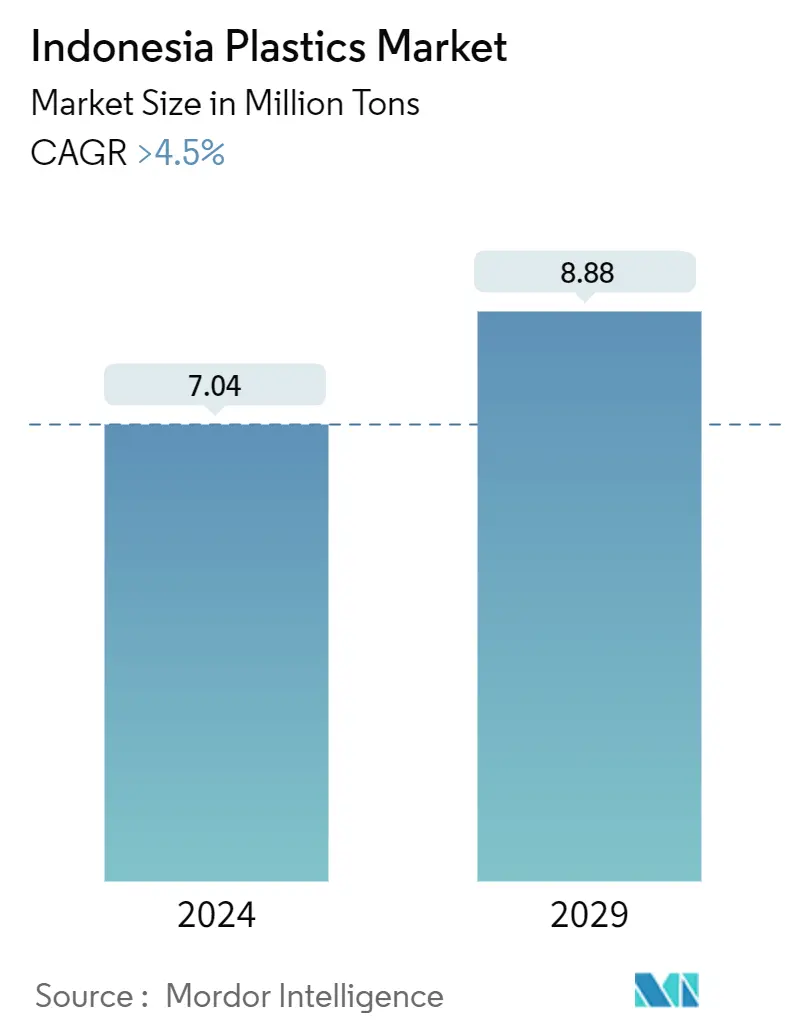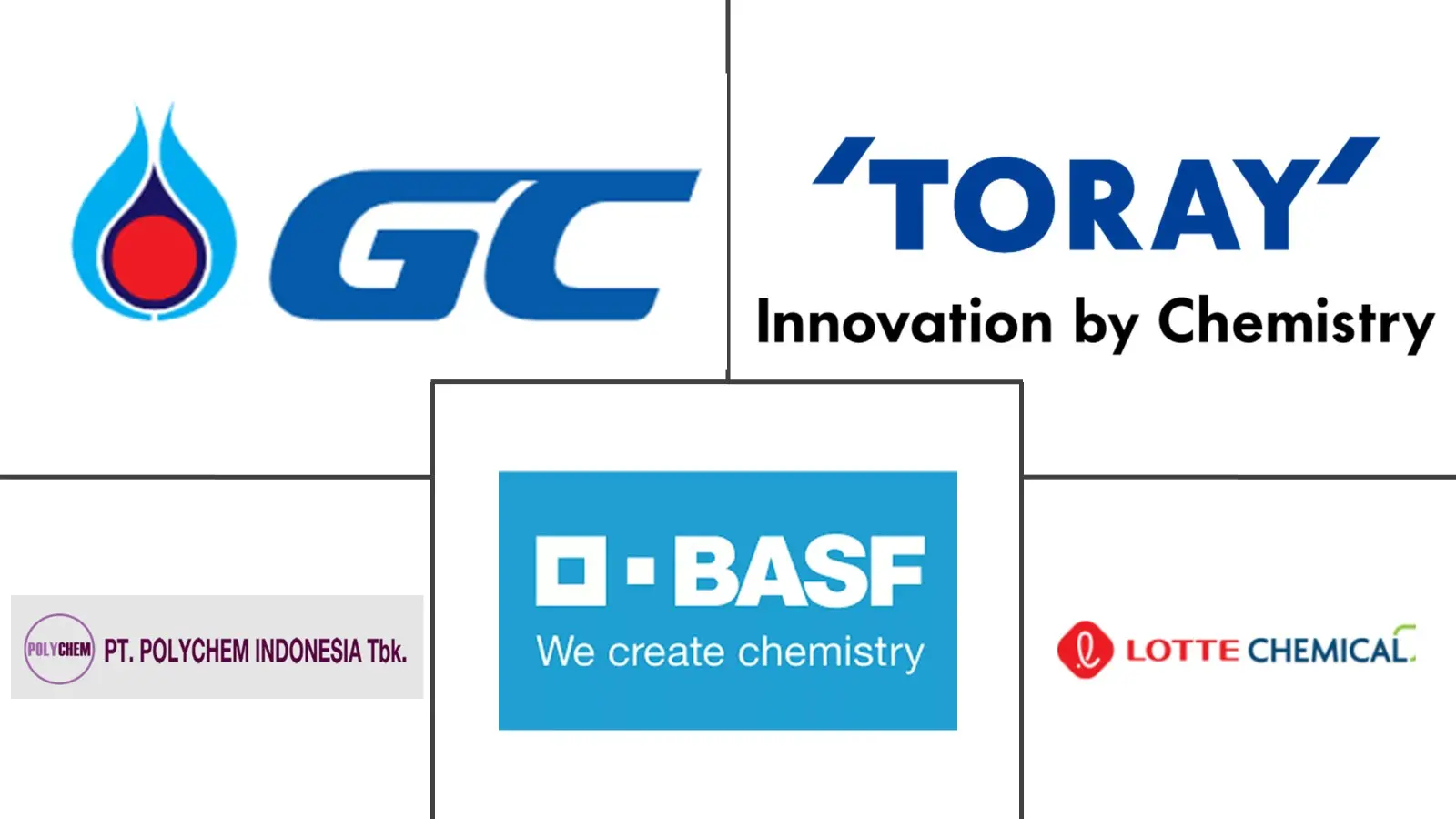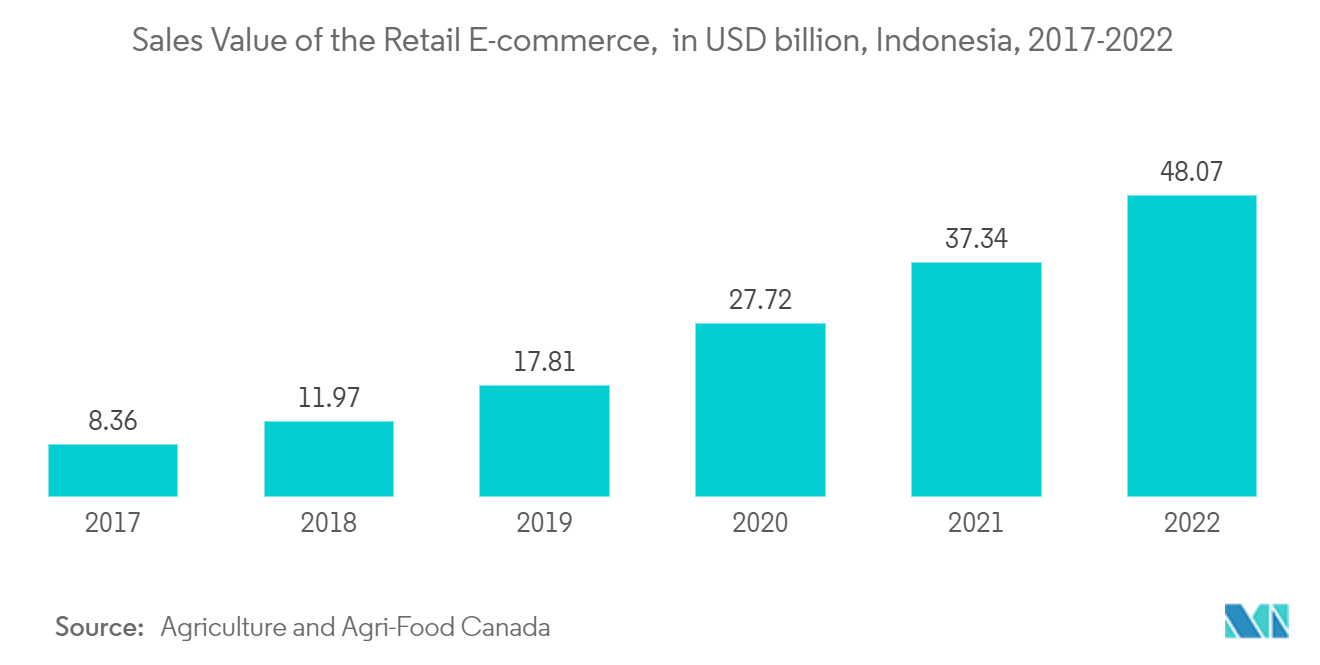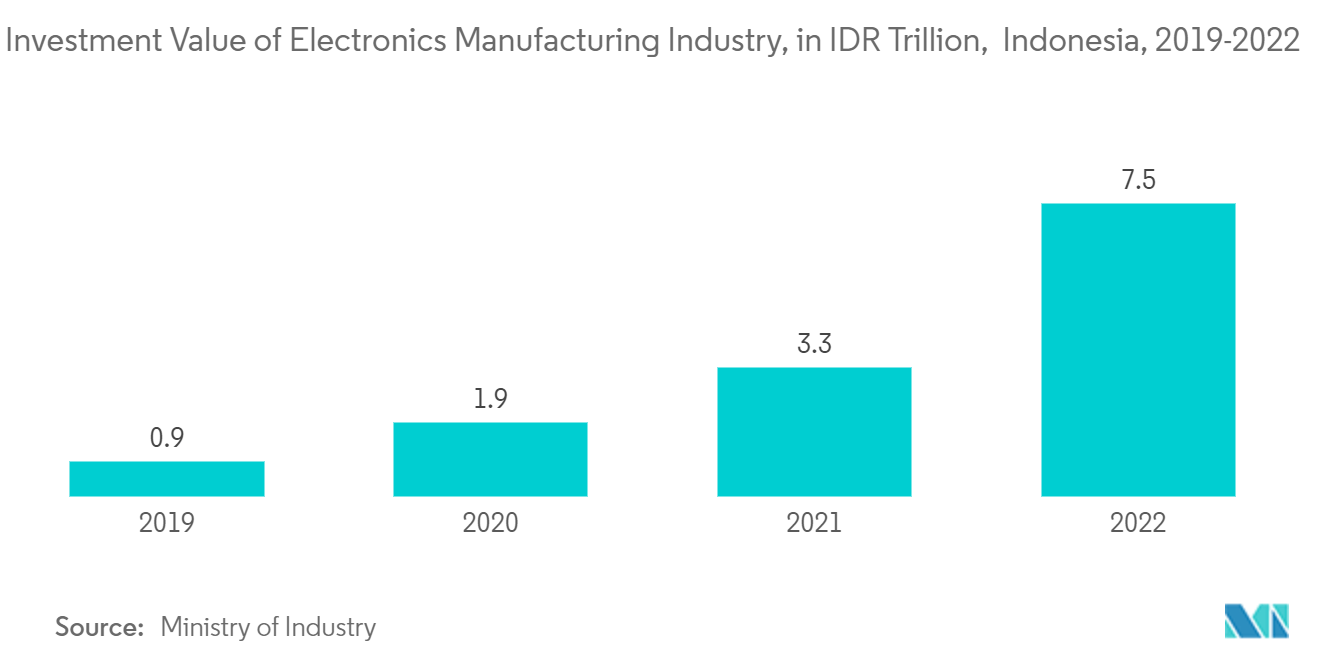Indonesia Plastics Market Size

| Study Period | 2019 - 2029 |
| Base Year For Estimation | 2023 |
| Forecast Data Period | 2024 - 2029 |
| Historical Data Period | 2019 - 2022 |
| CAGR (2024 - 2029) | 4.50 % |
| Market Concentration | High |
Major Players
*Disclaimer: Major Players sorted in no particular order |
Indonesia Plastics Market Analysis
The Indonesia Plastics Market size is estimated at 7.04 Million tons in 2024, and is expected to reach 8.88 Million tons by 2029, growing at a CAGR of greater than 4.5% during the forecast period (2024-2029).
The COVID-19 pandemic negatively impacted the country's production and supply of plastics during the lockdown. However, the demand from the packaging segment surged due to the increasing use of online food and retail e-commerce services during the pandemic. After 2020, the market improved steadily due to continuous activities within the country.
- Over the medium term, growing demand from the end-user industries, such as packaging, electrical, and electronics, as well as the construction industry, along with the rapid increase in the downstream processing capacity additions, is expected to drive the growth of the market studied.
- However, government regulations on the use of plastics and over-reliance on the imports of raw materials are the primary factors hindering the growth of the market studied.
- Nevertheless, the rising demand for eco-friendly products is expected to offer various opportunities for the growth of the market studied.
Indonesia Plastics Market Trends
Growing Demand from the Packaging Industry
- The primary utilization of plastics is in the packaging segment due to better wear and chemical resistance, ease of molding, recyclability, puncture resistance, and high mechanical strength. Furthermore, polyethylene terephthalate (PET) is Indonesia's most common plastic used for packaging purposes.
- Plastics are more commonly used in the food, retail, and pharmaceutical sectors for packaging goods due to their properties, such as portability, design flexibility, ease of cleaning, lightweight, and protection against moisture over other materials. In addition, low handling hazards, low toxicity, and the absence of bisphenol A (BPA) and heavy metals are other factors that allow PET to be used for food packaging.
- In the pharmaceutical industry, plastics are commonly used for packaging blood bags, syringes, nebulizers, and medicine bottles. Furthermore, the growing population in Indonesia is the main reason for pharmaceutical development, which has increased the consumption of plastics within the country.
- In Indonesia, the use of plastics for packaging goods is increasing in the e-commerce industry. For instance, according to Agriculture and Agri-Food Canada, the sales value of retail e-commerce in Indonesia was valued at USD 48.07 billion in 2022. It is forecasted to reach USD 90.47 billion in 2026.
- According to the United States Department of Agriculture, the retail sales value of packaged foods in Indonesia reached USD 37. 5 billion in 2022 and registered growth when compared to USD 33.4 billion in 2021. This trend, which shows the growing consumption of plastics in food packaging within the country, is expected to continue.
- Plastic materials play a crucial role in pharmaceutical packaging, offering qualities such as durability, flexibility, and the ability to maintain the integrity of medicines. Plastic bottles, blister packs, and vials are common examples.
- Plastic is commonly chosen for aseptic packaging due to its effective barrier properties, flexibility, lightweight nature, cost-effectiveness, transparency, reliability features, and ongoing innovations. However, there is an increased focus on developing sustainable alternatives to address environmental concerns associated with plastic waste.
- In a move to bolster the plastic industry, Lamipak, a prominent leader in delivering top-quality products and solutions for aseptic packaging, revealed its plans to build a second factory in Indonesia in May 2022, demonstrating a substantial investment of USD 160 million.
- The factors mentioned above are expected to have a considerable impact on Inodnesia's demand for plastic during the forecast period.

Injection Molding Technology to Dominate the Market
- In injection molding technology, the thermoplastic polymer is heated above its melting point and converted into a molten form of low viscosity. This molten plastic is then forced and injected into a mold of the desired shape to get the desired product.
- Injection molding technology is used to make the shape of simple or complex plastics such as helmets, bottle caps, and fans using thermoplastic polymers. It is also used for wire insulation, bottles, and cosmetics packaging.
- Injection molding is done using high-quality processing resins. It has several advantages: design flexibility, cost-effectiveness, fast manufacturing process, low labor costs, reasonable color control, and good product quality. In addition, this process is mostly capital-consuming, but it offers better and more accurate products than other technology types.
- The pharmaceutical industry's demand for injection molding is increasing since it is utilized to manufacture various medical equipment parts such as beakers, test tubes, caps, seals, closures, valves, syringes, and inhalers. Furthermore, according to the UN Comtrade, Indonesia spent approximately USD 1.51 billion on imported pharmaceutical products in 2022. This trend demonstrates future opportunities for injection molding technology in the pharmaceutical sector.
- Injection molding is more extensively used in the manufacturing of automotive parts such as door panels, bumpers, grilles, light housings, fenders, and other parts. According to the Organisation Internationale des Constructeurs d'Automobiles (OICA), Indonesia produced around 1.21 million units of vehicles in 2022, witnessing a growth rate of 37.5% as compared to the previous year.
- Furthermore, plastics play a crucial role in the electronics industry, serving as lightweight and durable materials for casings, enclosures, components, and connectors, providing insulation for wiring and circuit boards, contributing to the production of printed circuit boards (PCBs), facilitating packaging, creating displays and screens, enabling 3D printing of prototypes, and offering antistatic properties to prevent damage to electronic components.
- According to the Ministry of Industry, the investment value of the electronics manufacturing industry in Indonesia reached IDR 7.5 trillion (USD 0.48 billion) in 2022.
- Due to the factors mentioned above, the market studied is expected to have steady growth during the forecast period.

Indonesia Plastics Industry Overview
The Indonesian plastics market is consolidated. Some major players in the market (not in any particular order) include BASF SE, PT LOTTE CHEMICAL TITAN Tbk, PTT Global Chemical Public Company Limited, PT Polychem Indonesia Tbk, and TORAY INDUSTRIES INC., among others.
Indonesia Plastics Market Leaders
-
BASF SE
-
PT LOTTE CHEMICAL TITAN Tbk
-
PTT Global Chemical Public Company Limited
-
PT Polychem Indonesia Tbk
-
TORAY INDUSTRIES, INC.
*Disclaimer: Major Players sorted in no particular order

Indonesia Plastics Market News
- November 2022: ExxonMobil and PT Indomobil Prima Energi (IPE) signed a memorandum of understanding (MoU) to explore the potential for the large-scale implementation of advanced plastic recycling technology in Indonesia.
- September 2022: Toyobo announced an investment of USD 72 million to open a new polyester film packaging facility at Pt. Trias Toyobo Astria (TTA) in Indonesia. Through the expansion, the company has strengthened its market presence.
Indonesia Plastics Market Report - Table of Contents
1. INTRODUCTION
- 1.1 Study Assumptions
- 1.2 Scope of the Study
2. RESEARCH METHODOLOGY
3. EXECUTIVE SUMMARY
4. MARKET DYNAMICS
-
4.1 Drivers
- 4.1.1 Growing Demand from the End-user Industries
- 4.1.2 Rapid Increase in the Downstream Processing Capacity Additions
- 4.1.3 Other Drivers
-
4.2 Restraints
- 4.2.1 Over-reliance on the Imports of Raw Materials
- 4.2.2 Government Regulations on the Use of Plastics
- 4.3 Industry Value Chain Analysis
-
4.4 Porter's Five Forces Analysis
- 4.4.1 Bargaining Power of Suppliers
- 4.4.2 Bargaining Power of Buyers
- 4.4.3 Threat of New Entrants
- 4.4.4 Threat of Substitute Products and Services
- 4.4.5 Degree of Competition
5. MARKET SEGMENTATION (Market Size by Volume)
-
5.1 Type
- 5.1.1 Traditional Plastics
- 5.1.1.1 Polyethylene
- 5.1.1.2 Polypropylene
- 5.1.1.3 Polyvinyl Chloride
- 5.1.1.4 Polystyrene
- 5.1.2 Engineering Plastics
- 5.1.2.1 Polyethylene Terephthalate (PET)
- 5.1.2.2 Polybutylene Terephthalate (PBT)
- 5.1.2.3 Polycarbonates(PC)
- 5.1.2.4 Styrene Polymers (ABS & SAN)
- 5.1.2.5 Fluoropolymers
- 5.1.2.6 Polyoxymethylene (POM)
- 5.1.2.7 Polymethyl Methacrylate (PMMA)
- 5.1.2.8 Polyamide (PA)
- 5.1.2.9 Other Engineering Plastics (Liquid Crystal Polymer, Polyether Ether Ketone)
- 5.1.3 Bioplastics
-
5.2 Technology
- 5.2.1 Injection Molding
- 5.2.2 Extrusion Molding
- 5.2.3 Blow Molding
- 5.2.4 Other Technologies
-
5.3 Application
- 5.3.1 Packaging
- 5.3.2 Electrical and Electronics
- 5.3.3 Building and Construction
- 5.3.4 Automotive and Transportation
- 5.3.5 Furniture and Bedding
- 5.3.6 Other Applications (Houseware)
6. COMPETITIVE LANDSCAPE
- 6.1 Mergers and Acquisitions, Joint Ventures, Collaborations, and Agreements
- 6.2 Market Share (%)**/Ranking Analysis
- 6.3 Strategies Adopted by Leading Players
-
6.4 Company Profiles
- 6.4.1 Asahimas Chemical Company
- 6.4.2 BASF SE
- 6.4.3 LOTTE CHEMICAL TITAN HOLDING BERHAD.
- 6.4.4 PT. INNAN
- 6.4.5 PT Pertamina(Persero)
- 6.4.6 PT Polychem Indonesia Tbk
- 6.4.7 PT Chandra Asri Petrochemical
- 6.4.8 LyondellBasell Industries Holdings BV
- 6.4.9 PT. Standard Toyo Polymer (Tosoh Corporation)
- 6.4.10 Sulfindo Adiusaha
- 6.4.11 PTT Global Chemical Public Company Limited
- 6.4.12 P.T. Solvay Chemicals Indonesia
- 6.4.13 P.T. Toray International Indonesia
- *List Not Exhaustive
7. MARKET OPPORTUNITIES AND FUTURE TRENDS
- 7.1 Rising demand for Eco-friendly Products
- 7.2 Other Opportunities
Indonesia Plastics Industry Segmentation
Plastic is an artificial substance produced from polymers, large molecules composed of repeating subunits. These polymers are commonly derived from petrochemicals, although some plastics can be made from natural materials. The distinctive feature of plastics lies in their ability to undergo deformation and take on various forms when exposed to heat or pressure.
The Indonesian plastics market is segmented by product type, technology, and application. By product type, the market is segmented into traditional plastics and engineering plastics. By technology, the market is segmented into injection molding, extrusion molding, blow molding, and other technologies (rotational molding, thermoforming, and others). By application, the market is segmented into packaging, automotive and transportation, building and construction, electrical and electronics, furniture and bedding, and other applications (houseware, medical, and others). For each segment, the market sizing and forecasts were made based on volume (tons).
| Type | Traditional Plastics | Polyethylene |
| Polypropylene | ||
| Polyvinyl Chloride | ||
| Polystyrene | ||
| Type | Engineering Plastics | Polyethylene Terephthalate (PET) |
| Polybutylene Terephthalate (PBT) | ||
| Polycarbonates(PC) | ||
| Styrene Polymers (ABS & SAN) | ||
| Fluoropolymers | ||
| Polyoxymethylene (POM) | ||
| Polymethyl Methacrylate (PMMA) | ||
| Polyamide (PA) | ||
| Other Engineering Plastics (Liquid Crystal Polymer, Polyether Ether Ketone) | ||
| Type | Bioplastics | |
| Technology | Injection Molding | |
| Extrusion Molding | ||
| Blow Molding | ||
| Other Technologies | ||
| Application | Packaging | |
| Electrical and Electronics | ||
| Building and Construction | ||
| Automotive and Transportation | ||
| Furniture and Bedding | ||
| Other Applications (Houseware) |
Indonesia Plastics Market Research FAQs
How big is the Indonesia Plastics Market?
The Indonesia Plastics Market size is expected to reach 7.04 million tons in 2024 and grow at a CAGR of greater than 4.5% to reach 8.88 million tons by 2029.
What is the current Indonesia Plastics Market size?
In 2024, the Indonesia Plastics Market size is expected to reach 7.04 million tons.
Who are the key players in Indonesia Plastics Market?
BASF SE, PT LOTTE CHEMICAL TITAN Tbk, PTT Global Chemical Public Company Limited, PT Polychem Indonesia Tbk and TORAY INDUSTRIES, INC. are the major companies operating in the Indonesia Plastics Market.
What years does this Indonesia Plastics Market cover, and what was the market size in 2023?
In 2023, the Indonesia Plastics Market size was estimated at 6.72 million tons. The report covers the Indonesia Plastics Market historical market size for years: 2019, 2020, 2021, 2022 and 2023. The report also forecasts the Indonesia Plastics Market size for years: 2024, 2025, 2026, 2027, 2028 and 2029.
Indonesia Plastics Industry Report
Statistics for the 2024 Indonesia Plastics market share, size and revenue growth rate, created by Mordor Intelligence™ Industry Reports. Indonesia Plastics analysis includes a market forecast outlook to 2029 and historical overview. Get a sample of this industry analysis as a free report PDF download.



